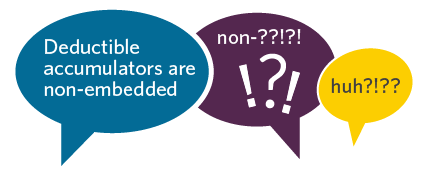
Explaining the embedded deductible: Your latest employee benefits communication challenge
The Affordable Care Act was designed, in part, to make health insurance easier for consumers to understand. But in a surprising twist, it’s more confusing, confounding, and frustrating than ever, largely because it seems to have a language all its own. For example, the term “deductible accumulators” is now part of the insurance vernacular. And if you’re furrowing your brow to comprehend this baffling phrase, imagine what your employees will think when they see it—or other mystifying vocabulary.
As someone who loves helping employees better understand and use their benefits, I thought I’d seen and explained—in common language—my fair share of bewildering insurance expressions—including “premium,” “contribution,” “deductible,” “copayment,” and everyone’s favorite, “coinsurance.” But while I was going through our annual enrollment process recently, I came up against the Big Kahuna of inexplicable insurance techno-speak: “The 2015 deductible accumulators were non-embedded.”

My first reaction: What the H-E-double hockey sticks is a “non-embedded deductible accumulator?” Which led to my second reaction: Why in the name of ERISA would anyone use that term in employee communications? And it wasn’t just me. Within the Benz Communications walls are more than 100 combined years of experience unraveling formidable, weapons-grade jargon. Yet the term left many of us equally perplexed.
Now imagine how the average employee would react. Or, more accurately, not react. In most cases, people will avoid that sort of verbal quicksand at all costs. Which, unfortunately, means they’ll be missing out on what a great feature an embedded deductible accumulator is.
If you don’t spend your days scouring the Department of Health and Human Services (HHS) website, here’s the translation: If you’re covering yourself and any other family members, once one family member meets the individual deductible, that person’s deductible is satisfied—even though the family deductible hasn’t been met. No more having to pay the entire family deductible before the plan kicks in for health care costs.
While embedded deductibles aren’t required by law, embedded out-of-pocket maximums are. In March 2016, HHS announced that high-deductible health plans (HDHPs) must apply an embedded self-only, out-of-pocket (OOP) maximum to each individual who is enrolled in family coverage if the family OOP maximum is more than $6,850 (for 2016). This is the same idea as an embedded deductible: Once one family member meets the individual out-of-pocket maximum, the plan will cover 100% of that person’s additional medical expenses for the rest of the plan year.
So, an embedded deductible or out-of-pocket maximum could change the way your employees think about a high-deductible plan—and even encourage some who are holding out to give it a shot. But if the term “embedded deductible” or “embedded out-of-pocket maximum” comes within five feet of your communications, your employees will never understand it, care about it, or consider enrolling in an HDHP because of it.
For easy-to-understand explanations of new embedded out-of-pocket maximum legislation, its impact on your organization, and links to the HHS guidance, check out the Society for Human Resource Management.
Your benefits are designed for humans, to be used by humans. To get the most out of the huge investment you make in your plans every year, seek first to be understood. Or, in everyday language: Ditch the benefits-speak and talk to employees like they’re people. Especially during the upcoming open enrollment season, when clear and actionable should be your communications mantra. Download our new white paper, 5 Ways to engage employees in health education and build health literacy to learn how to give your employees the information they need to choose and use their benefits correctly.
We’d love to hear your favorite insurance buzzwords. Drop us a line at hello@benzcommunications.com and tell us yours. Who knows? They could end up in one of our future blog posts.
Work with Us
We partner with organizations that value their people first. Let’s talk.

Rita Harris, VP Senior Consultant, is known for her ability to break down complex benefits programs into their essential parts, so employees can quickly assess “what’s in it for me.”
